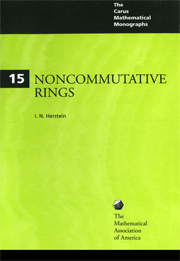3 - COMMUTATIVITY THEOREMS
Summary
In the preceding two chapters we laid out a general line of attack on ring-theoretic problems. This procedure is especially efficacious in proving that appropriately conditioned rings are commutative, or almost so. The reason for this lies in the trivial fact that a subring of a direct product of commutative rings is itself commutative. In the theorems to be considered we shall see clearly the role assumed by this general structure theory in the disposition of the problems at hand. Most particularly they illustrate effectively the point made earlier that in this kind of approach the difficulties usually present themselves at two stages, namely in the first step of establishing the result for division rings and in the last one of climbing back through the radical. This area of results together with that of rings with polynomial identities (which we consider later) are probably those parts of ring theory in which the structure theory has had its most successful play.
Wedderburn's Theorem and some generalizations. In 1905 Wedderburn proved that a finite division ring is a field. Aside from its own intrinsic beauty this result plays an important role in many diverse parts of algebra—in the theory of group representation and in the theory of algebras to cite two examples. It provides the only known proofs of the fact that in a finite projective plane Desargues' theorem implies that of Pappus'. For us it will serve as the starting point for an investigation of certain kinds of conditions that render a ring commutative.
- Type
- Chapter
- Information
- Noncommutative Rings , pp. 69 - 88Publisher: Mathematical Association of AmericaPrint publication year: 1968
- 1
- Cited by



